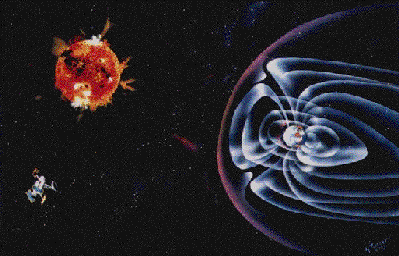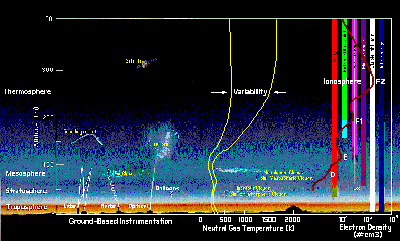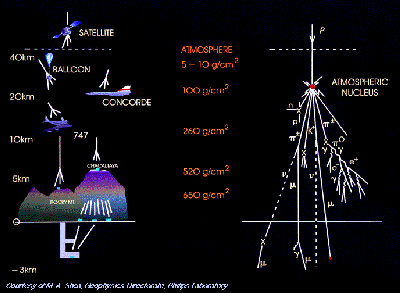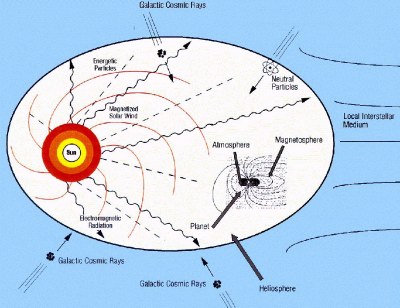www.moonlandings.co.uk
The Moon | Radiation & Van Allen Belts | A Void of Space | Space Cameras | Temperature | Photograph Anomolies
A Void of Space
Or is it? Contrary to what may be commonly assumed, space is not empty. Space may be described as a vacuum, but it is filled with low energy charged particles, photons, electric and magnetic fields, dust and cosmic rays. The densities of these things are low, particularly for the particulate matter, compared to, for example, the atmospheric density at the surface of the Earth but they are high enough to affect spacecraft, humans in space and even occasionally human activities on Earth. Moreover, there are changes in the space environment; sometimes violent and dramatic changes. These may be visibly manifested in dramatic auroral displays. We call this space weather and it originates on the sun.
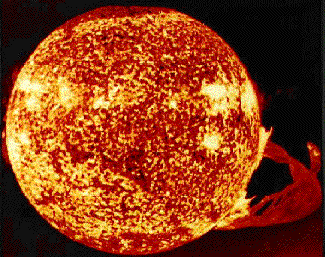
Image of the Sun in ultraviolet light showing a large prominence at the limb (from: The Space Physics Group at Oulu, Finland)
The surface magnetic field of the sun is concentrated in sunspots, which appear dark because the material in the sunspot is much cooler than the surrounding material. Sunspots often appear in groups called active regions. (A close-up picture of a sunspot may be found here 88KB)
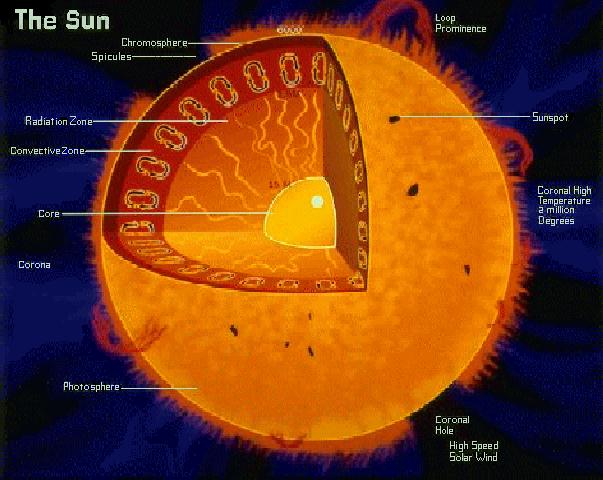
Cutaway diagram showing what is thought to be inside the Sun (from: The Space Science Institute)
Above the solar surface stretches the extended solar atmosphere, known as the solar corona. Propagating waves and/or processes associated with the constant rearrangement of the magnetic fields close to the Sun raise the temperature of the corona (to over 1,000,000 Kelvin), far above that of the solar surface (at about 6000 degrees Kelvin). Because of its temperature, the coronal gas is highly ionised and so its structure is affected by the coronal magnetic field.
The solar magnetic field evolves over the solar cycle along with the sunspot number. Driven by the motions of the ionised gases beneath the visible surface, the North and South poles of the solar magnetic field reverse approximately every eleven years around sunspot number maximum. As a result, there is a roughly 22-year cycle in the Sun's magnetic 'polarity', with the North or South magnetic pole in the northern hemisphere of the Sun during alternate sunspot maxima. The field is more complicated at solar maximum when the simple solar minimum structure, which resembles Earth's field or that of a bar magnet, is disrupted by the strong fields of many active regions (see animation of coronal ejections)
Processes related to this evolution of the solar magnetic field are the ultimate causes of space weather. Effects of the 22-year magnetic cycle can be seen in some space weather records, but it is primarily the 11-year cycle of activity that is of concern in space weather.
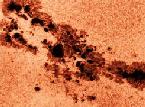 The surface magnetic field of the sun is concentrated in sunspots, which appear dark because the material in the sunspot is much cooler than the surrounding material. Sunspots often appear in groups called active regions (Views of the Solar System)
The surface magnetic field of the sun is concentrated in sunspots, which appear dark because the material in the sunspot is much cooler than the surrounding material. Sunspots often appear in groups called active regions (Views of the Solar System)The Solar Wind
The high temperature of the solar upper atmosphere generates an outward flow of the ionised coronal gas or plasma away from the Sun at typical speeds ranging from 400 to 800 kilometres per second. This outflow is known as the 'solar wind'. At the Earth (1 astronomical unit (AU) or 150 million kilometres away from the Sun), 1 cubic centimetre of solar wind contains about 8 protons and an equal number of electrons (so there is no net electrical charge in the gas). Helium and heavier ions are also present in the solar wind but in smaller numbers.
Since the Skylab mission in 1973, it has been realised that the solar wind does not flow uniformly from everywhere on the Sun. Measurements have shown that it comes mainly from low-density regions in the corona called 'coronal holes'. Coronal holes are so-named because they appear dark in x-ray images of the Sun. They are usually located in the Sun's polar regions, but their irregular boundaries can dip into low solar latitudes where they affect conditions in interplanetary space. In general, the sizes, shapes and distributions of coronal holes change over the solar cycle, with the largest coronal holes appearing around sunspot minimum when the coronal magnetic field has a simple configuration. The highest-speed solar wind streams observed at the Earth are often associated with these large coronal hole sources.
Coronal magnetic fields are constantly being carried with the solar wind into interplanetary space. The solar rotation winds up the field into a spiral resembling the water streams from a rotating garden sprinkler because the source of the field keeps moving with the Sun.
Our earth is immersed in the extended atmosphere of the sun. This extended atmosphere is called the solar wind (see picture above). The solar wind is a fully ionised gas that literally explodes continuosly from the solar corona, the outer region of the sun's dense atmosphere. The solar wind is driven away from the sun by thermal pressure from the two million degree corona at supersonic velocities, about 500 km/s. When it gets as far away as the orbit of the earth, 150 million km, it is still accelerating and it keeps on going as far as we have been able to probe with our most distant spacecraft, Pioneers 10 and 11 and Voyagers 1 and 2, near the outer reaches of the solar system. It probably finally runs into the interstellar medium and forms a supersonic shock front at that point.
At the Earth's distance from the Sun, the typical interplanetary magnetic field strength is about 5 nano teslas, or about 1/10,000 the strength of the Earth's magnetic field at the surface. The 'polarity' of the interplanetary magnetic field depends on the direction of the coronal field at its roots. The interplanetary field is typically organised into hemispheres of inward and outward field corresponding to the North and South magnetic poles of the solar field. The two hemispheres are separated by a sheet-like boundary carrying an electrical current. The interplanetary magnetic field directions reverse with the Sun's magnetic polarity near sunspot maxima.
Since the solar field is not a perfect configuration with simple North and South poles aligned along the Sun's rotation axis, the current sheet often has ripples like a ballerina's skirt.
The solar wind hits the Earth's magnetic field. Because the solar wind is mostly charged particles, electrons and protons, it cannot easily penetrate the earth's field. It meets an immovable obstacle and it forms a shock front and tries to flow around the sides in a manner very much analogous to a supersonic aircraft moving through the atmosphere. In so doing, it compresses and confines the magnetic field on the side toward the sun and stretches it out into a long tail on the night side. The magnetic cavity formed by this process is called the 'magnetosphere'. In the process, energy and charged particles are transferred from the solar wind to the magnetosphere. This results in a rich variety of phenomena, which includes the aurora borealis and aurora australis.
The radiation belts are a population of energetic charged particles surrounding the Earth and trapped there by the planet's magnetic field. As seen in the figure below, an electrically charged particle trapped in the magnetic field of a planetary dipole experiences three types of motion:
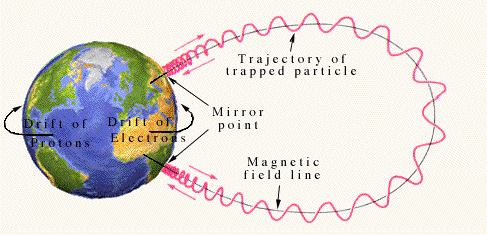
Processes analogous to those in the Sun's interior work in the molten core of the Earth to generate our own magnetic field. The Earth's field is even more like that of a bar magnet than the solar field, with oppositely located North and South poles characterising its very 'dipolar' (two-pole) structure. The highly conducting solar wind gas is not able to penetrate Earth's magnetic field at most locations, instead flowing around it. Before it is diverted, however, it slows down at a (shock) wave called the 'bow shock' that stands upstream of Earth in the solar wind. The picture at the top of this page shows a bow shock standing upstream of the Earth in the solar wind plasma. It serves to slow the flowing ionised gas before it encounters the obstacle presented by the Earth's magnetic field, analogous to air flow around a supersonic aircraft.
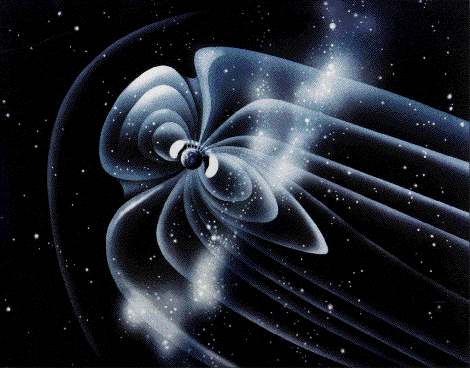
The diversion of the solar wind flow generally occurs at about 6 to 15 Earth radii above Earth's sunlit surface, where the variable solar wind plasma 'ram' pressure is balanced by the pressure of the compressed dipolar field of Earth. The cavity that Earth's field makes in the solar wind stretches out into a long 'magnetotail' on the nightside. This cavity and everything inside it make up the 'magnetosphere'. The size of the magnetosphere is smallest when the solar wind is strong, sometimes pushing the dayside boundary inside of the orbit of geosynchronous satellites.
Since the beginning of the space age in 1957, and even before, scientists have been probing and defining regions of the magnetosphere and trying to understand how they arise. We now have a fairly good understanding of the morphology of the magnetosphere, pictured in the cut-away cartoon below.
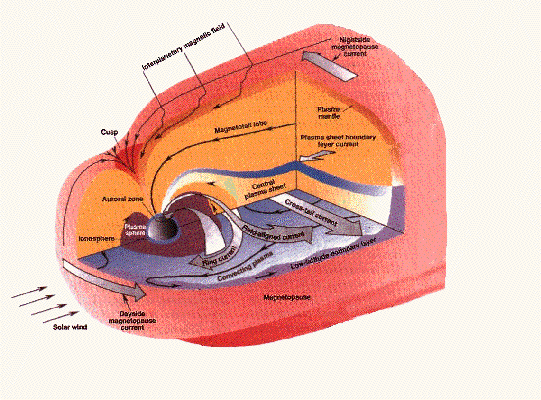
The magnetosphere is the region of space above the atmosphere that is dominated by the Earth's magnetic field. This cutaway illustration shows the major structural features of this complex, dynamical system derived from spacecraft observations in many different orbits (Source)
In the view above, we are looking from the side and down on the equatorial plane. The edge of the magnetosphere, the magnetopause, is clearly delineated. Just inside the magnetopause is a thin layer called the mantle. The magnetic field lines from the dayside of the magnetosphere are drawn over the poles and into the night side to form this long stretched tail. In the process, they form the northern and southern lobes which are separated from each other by a very interesting region called the plasma sheet. In the plasma sheet, by some process not yet fully understood, the magnetic energy of the lobes is converted to plasma kinetic energy. A plasma is a gas that is fully ionised, ie the atoms, mostly hydrogen, have had all of their electrons removed. Although almost unknown to us on Earth, taking the universe as a whole, plasma is the most common form of matter, being found mostly in stars. Plasma is generally considered to be electrically neutral, but the fact that the atoms are ionized means that the weak magnetic and electric fields that pervade the region strongly influence the charged particle motion. In fact, the definition of the magnetosphere is that region where the Earth's magnetic field controls the particle behaviour. The story of the dynamics of the magnetosphere is one of motion of particles from the solar wind and the Earth's ionosphere being shoved around and energised by electric and magnetic fields.
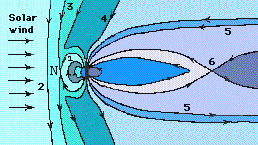
Right: showing why southward-oriented interplanetary fields are more effective at transferring energy from the solar wind to the magnetosphere. The interconnection between the interplanetary and geomagnetic field is enabled at the 'nose' of the magnetosphere because the fields are oppositely directed there. Once connected, the fields move roughly as indicated by the sequence of numbers (Source)
The auroral ovals are located in the polar regions bordering the area threaded by the interconnected fields. Here, energetic charged particles from both the solar wind and the magnetosphere precipitate or 'rain' into the atmosphere from above. This rain of typically kilovolt-energy particles is responsible for the aurora borealis and aurora australis, produced when atmospheric atoms and molecules energised by collisions with the incoming particles emit light.
Several concentrations of charged-particle populations with different origins, densities and energies are found in the magnetosphere. The Van Allen radiation belts are one such population with sources as diverse as the decay products of cosmic-ray collisions with atmospheric atoms and ions that originated in the interstellar gas.
Earth's upper atmosphere is another source of particles for the magnetosphere. Ionised atmospheric gases at high altitudes can be energised and transported around by a variety of processes that are still under scientific study. The ions and electrons in the magnetosphere carry electrical currents that produce deviations in the magnetic field measured on the ground as well as in space.
The Upper Atmosphere and Ionosphere
At the base of the magnetosphere lie the upper reaches of Earth's atmosphere and ionosphere. The upper atmosphere is composed of atoms and molecules of gases such as oxygen and nitrogen, which become increasingly sparse with increasing altitude. At the 300- to 400- kilometre altitude of the shuttle orbit, the atmospheric density is on the order of 300 million (300,000,000) particles per cubic centimetre or about 1/10,000,000,000 times the density of all of the gases of the air at the ground. At typical weather satellite orbit altitudes (about 850 kilometres), the density is down to 1/100 to 1/1000 times the density at the shuttle orbit. However, these densities can increase by more than ten times when the upper atmosphere is heated by strong solar ultraviolet radiation at solar maximum or by processes occurring during disturbed space weather.
The ionosphere is the region of the atmosphere above 60-kilometre altitude that is slightly ionised by solar ultraviolet radiation. The UV radiation can eject negatively charged electrons from their 'parent' atoms and molecules to make positively charged ions. These charged particles live between minutes and hours before recombining to again form neutral or uncharged gas particles in an ongoing cycle of ionisation and recombination. On the average, the abundance of charged particles increases with altitude up to about 300 kilometres, decreasing gradually at higher altitudes (see the figure below). Ionisation by energetic cosmic-ray particles contributes some of the lowest-altitude ionosphere.
Illustration of the upper-atmosphere temperature variability and the regions of Earth's ionosphere, which are labeled by letters. The various ionospheric peaks are the result of the various sources of atmosphere ionization and the atmospheric chemistry at different altitudes
Cosmic Rays
In addition to the space environment already discussed, Earth is immersed in an extremely tenuous bath of high-energy charged particles called cosmic rays. Most cosmic rays enter the solar system from the galaxy, but solar flares contribute on occasion and disturbances moving through the solar wind can energise particles in their path. Both solar wind particles as well as some originating from interstellar gas ionised in the vicinity of the Sun can be so energised. The cosmic rays produced within the solar system sometimes make up the dominant contribution near Earth. Although Earth's magnetic field acts like a shield, deflecting all but the fastest of these particles, even low-energy cosmic rays reach low altitudes in the polar regions where the planet's magnetic field interconnects with the interplanetary field. The most energetic cosmic rays can reach cloud levels (around 10-km altitude) where they affect cloud electrification, while a few may even reach the ground or create secondary particles in the atmosphere.
Cosmic rays can penetrate into the atmosphere, producing many 'secondary particles' as products of their collisions with atmospheric nuclei
Particles that are produced when cosmic rays interact with the thin upper atmosphere can become part of the Van Allen belts. The local density of cosmic rays varies with the solar activity cycle because the disturbed solar wind during solar maximum sweeps these particles out of the solar system more effectively than does the quiet solar wind.
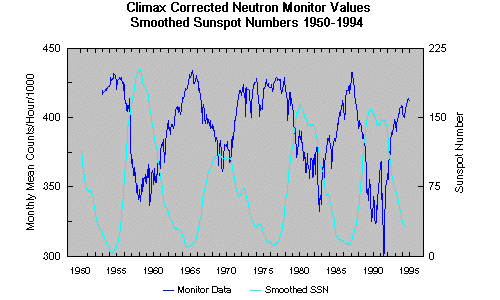
Data from the Climax, Colorado, neutron monitor operated by the University of Chicago. The cosmic rays counted exhibit an inverse relationship to the solar cycle because solar wind from the active Sun sweeps more away from the Earth than does solar wind from the quiet Sun (from: The NOAA National Geophysical Data Center, Boulder, CO)
The expanding solar wind forms a bubble in the interstellar material thought to extend at least 100 AU from the Sun. (For comparison, the outermost planet, Pluto, orbits the Sun at about 40 AU distance.) Space weather occurs everywhere within this bubble known as the 'heliosphere'. Every object in the solar system experiences the equivalent of Earth's space weather, although its detailed characteristics differ from place to place.
The heliosphere is a bubble, formed by the expanding solar wind, in the material between the stars (from: NASA's Solar Connections)
The solar wind also interacts with the other planets in our solar system. Differences in atmospheres and magnetic fields, however, alter the form and extent of that interaction.
